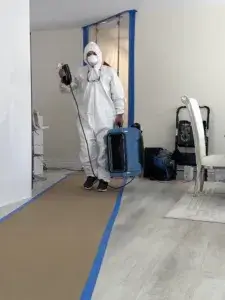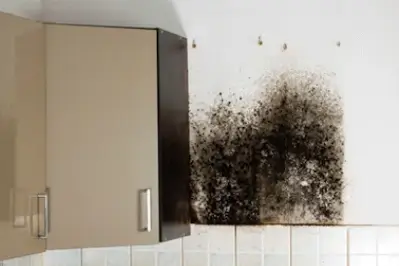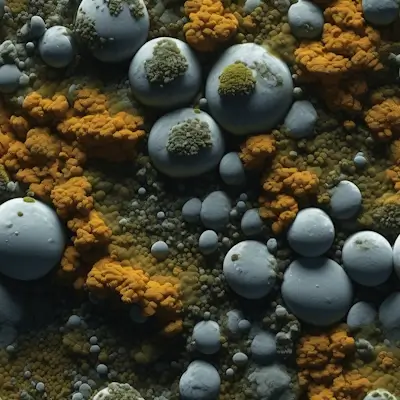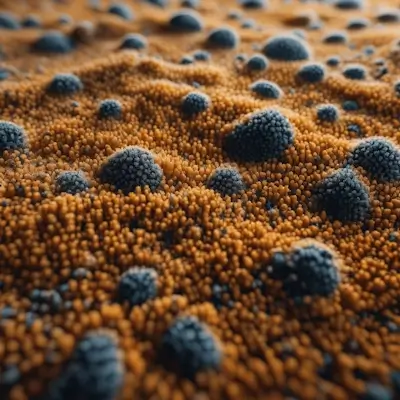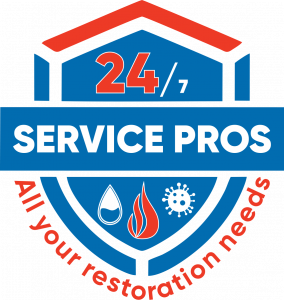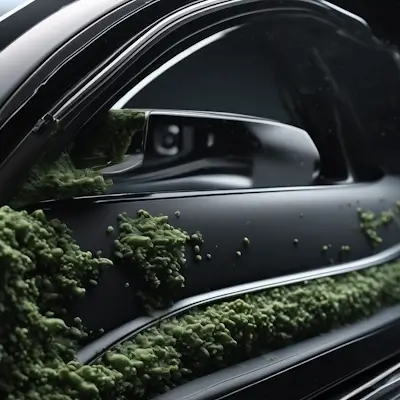
Mold can really stink up your car! They cause sneezing, coughing and yucky smells for you and your passengers. Some types of mold are even dangerous to your health.
Lots of things make mold grow – like humidity or keeping your car closed up for long times. It grows in nooks and crannies all over. Most mold is just annoying, but some like black mold can make you really sick.
Since all mold grows in similar places, it’s hard to tell what kind it is. The safe bet is to treat ALL mold as bad mold. Your comfort, health and safety in your car should be top priorities.
A dirty car with mold everywhere looks gross and is bad for you too. It can lead to breathing problems or other issues for anyone in the vehicle.
Keeping your car clean is important for how you feel and your ability to drive safely. So it’s crucial to take steps to get rid of any mold or mildew.
To make thing easier for you, we have compiled all the information and methods which you need to know to get rid of mold and mildew from your car. Let’s learn more. Shall we?
Table of contents
- Reasons of Mold and Mildew Growth In Cars
- Preparing Your Car For Mold and Mildew Removal
- Removing Mold and Mildew From Car’s Interior – Vinegar Method
- Brush and Scrub Method for Deep Cleaning Mold and Mildew from Upholstery
- Neutralize the Odor of Mold and Mildew in Cars
- Steps to Prevent Mold And Mildew Growth in Car
- DIY Mold and Mildew Removal From Cars – Salt Method
- In Short
Reasons of Mold and Mildew Growth In Cars
Mold and mildew are a type of fungi who love humid, warm and dark conditions to show best growth. Anything that promotes the mold development is an ideal reason behind mold cluster formation in the vehicles. Here are the different factors which contribute to mold growth in cars.
Poor Hygiene:
Car owners who fail to pay proper attention to vehicle hygiene cleanliness go through the trouble of facing mildew growth. Since these organisms need food to survive, poorly maintained vehicles are the best haven for mold to develop, multiply and grow. If you are someone who does not pay attention to interior car cleaning and detailing, you are very likely to become the next victim of mold growth in cars.
Non-Operational Vehicles:
Fully-closed, shut-down and non-operational vehicles stored in a dark place for months often exhibit mold formation. It is due to the fact that the spores which have already entered inside the car utilize the moisture and oxygen accumulated in a closed car to grow and multiply in size and form.
Climatic Factors:
If you live in an area that received heavy rainfall, floods, excessive humidity and moisture levels and short sun time, your car is very likely to show mold. Mold needs moisture to anchor and grow. A humid environment is just what is needed for the mold to grow as fast as they can. Similarly, if you live in a warm area that receives a lot of rainfall, you are likely to observe mold growth in your car.
Preparing Your Car For Mold and Mildew Removal
The minute you open the door of a mold or mildew infested car, you will instantly smell the foul “sour milk” odor and sense the dampness in the car’s interior. Mold and mildew have a characteristic smell which is neither pleasant nor safe to inhale. Before you head straight into the main mold removal methods for cars, here are some preparation tips you need to follow:
Buy and Wear Appropriate Personal Protection Gear
Let’s be clear: Mold Spores are not to be taken lightly. These growths may contain poisonous substances and harmful chemicals which can lead to damaging car owner’s health. Go to your nearby car hardware store and purchase a personal protection gear. Ensure that you wear masks, cover your head, wear gloves and completely cover any other exposed areas of your body before beginning the process.
Take the Car Out in The Sunlight
Mold hates sunlight and fresh air. Wear your personal protection gear, cover your face and take your infested vehicle out in bright sunlight. Carefully roll down all the windows and open the doors the allow the spore inflicted air move out of the car’s interior. Let the car soak in direct sunlight, with open doors and windows, for about 15 minutes.
Analyze the extent of mold growth to start planning
Evaluating, planning and strategizing are the key elements needed to eliminate the mold from any car. Get back in the car and inspect the nooks and crannies of the car including the areas under the seats, center console, doors and handles, dashboard, vents, seatbelts and ay damp or hidden spots. Identify the mold growth through general indicators and analyze how far it has spread so you can plan the removal methods accordingly.
Removing Mold and Mildew From Car’s Interior – Vinegar Method
Let’s welcome our old-school, cleaning buddy – Pure White Distilled Vinegar. Car owners and car care enthusiasts swear by the effectiveness of White Vinegar for removing the mold and mildew spores and getting rid of foul mildew odor. You can easily perform the White Vinegar mold removal practice at home.
Here is what you will need
- Standard car vacuum cleaner
- Pure White Distilled Vinegar
- Plastic Spray Bottle
- 2-3 Rags or Microfiber towels
Here Is How To Do It
- Manually remove any trash from your car to get a clean field to work on
- Use a standard car vacuum cleaner to remove dust, debris and gunk from car clothing
- Throw away any damp or soiled item present in the car
- Use your vacuum cleaner in the seat cracks, under the seat, near the armrests, floor mats, footrests and near the doors to pick up the dirt and gunk
- Take a fresh, properly washed or a new spray bottle. Pour White Distilled vinegar in to the spray bottle and start spraying this solution inside your car
- Spray the vinegar on the floor mats, interior walls, dashboard and central console directly
- Use the dry rags to wipe down the vinegar spray and get a fresh new look of the hard components of your car’s interior
- Leave the doors and windows open for a few minutes in the sun to ensure any excessive moisture is dried out
Brush and Scrub Method for Deep Cleaning Mold and Mildew from Upholstery
If you observe mildew clusters even after performing the initial pre-clean, it is time to take the problem more seriously. From the organic items to dust and debris lying in your car, everything is a great haven to promote mildew growth in the car. However, the problem of persistent and stubborn mold can be resolved by following the deep cleaning method.
Here is what you will need
- Pure White Distilled Vinegar
- Plastic Spray Bottle
- Tooth Brush
- Borax
- Wet-Dry Standard Vacuum
- Cotton Towel
Here is How To Do It
- Pre-cleaning: Repeat the same pre-cleaning steps as mentioned earlier
- Vinegar Attack: Spray the vinegar solution and soak the affected upholstery sections thoroughly. Let the affected areas soak in the vinegar solution for at least 10 minutes.
- Brush and Scrub: Use an old toothbrush and gently rub it on to the bigger and stubborn mold growth clusters. Do not rub harshly as it can lead to spore dispersal and a lot of mess.
- Wipe it Away: Use a cotton towel to wipe away the upholstery, fabric components and vinyl components of your car
- Vacuum Cleaning: Turn on the vacuum cleaner and use it to suck away the excessive moisture and solution from the target areas
- Reconditioning: Use a leather re-conditioner to restore the luster of the leather after using vinegar.
Alternatively
You can also use a natural fungicide, Borax, to remove the stubborn growth. Sprinkle the borax over the once-infected spots and let it act for 5 minutes. Use the vacuum cleaner to wipe away the area. This step will ensure that the spores do not grow again once you have removed them from your car.
TIP: Seal any cracks or spaces present between the doors, windows, handles or controls to ensure that no moisture or mold spores enter the car once you are done with cleaning.
Neutralize the Odor of Mold and Mildew in Cars
Although leaving your car doors and windows open in direct sunlight and opened area can reduce the foul smell, it cannot eliminate it completely. Once your mold removal job is complete, move on to using a good quality, refreshing deodorizer or air freshener in your car. You can also apply the old-school remedy of using a baking soda to remove the foul odor from your car and vacuum the baking soda away once the smell is gone.
Steps to Prevent Mold And Mildew Growth in Car
Mold will eventually come back if you fail to adopt necessary preventive measures. Mold has been observed to aggravate breathing issues, cause new allergies, worsen asthma and make the overall driving experience way too much unpleasant for the car occupants to bear.
Here are some steps which you can adopt to put mold growth in car in check:
Keep Away From Moisture
Moisture and humidity are among the top causes behind rapid growth of mold in cars. Instead of parking your car out in the open, park the car in a garage and cover it with waterproof cloth to eliminate moisture.
Tightly Close Doors and Windows
The spaces present between doors and windows work as an inlet to allow dust, debris and mold spores to enter the car. Ensure that your car windows are completely rolled up and that the doors are tightly closed to halt any entry of debris and spores in the car.
Avoid Dining In your Vehicle
Work on your habit of eating or drinking in vehicle and try to eliminate it over time. Food crumbs and spills serve as great substrates to accelerate mildew growth.
Disinfect Your Car
Another important thing to consider here is to properly clean and disinfect your car’s interior surfaces every now and then. Invest in a good quality disinfectant or antimicrobial agent to kill mold growth before it turns into trouble. Disinfect the sensitive car areas like:
- Door Handles
- Door Lock Buttons
- Power Window Buttons
- Key Fob or Push Button Start
- Steering Wheel
- Touchscreen & Infotainment System
- Gear Shifter
- Buttons on Dash
- Seat Belts and Insert Housings
- Glove Compartment
- AC/Heating System Vents
- AC/Heating Controls
- Turn Signals
- Side Door Arm Rests / Center Console
- Rear Seat Doors, Seat Belts, Door Controls
Clean Your Car Regularly
Your first and foremost duty as responsible and dedicated car owner shall be to ensure regular cleaning of your car to keep the dirt, debris and mold/mildew spores at bay. Clean your car’s interior every week and ensure there is no trace of mold/mildew development.
DIY Mold and Mildew Removal From Cars – Salt Method
The salt solution method is a useful alternative to the vinegar solution method. If you are hesitant to use vinegar on delicate car parts, mix non-iodized salt in water and pour the mixture in a spray bottle.
- Brush or spray the salt mixture on the target mold-infested surface
- Spray upt o 2 feet of the adjacent area surrounding the main area of infestation
- Let the solution dry for 10 minutes and use a vacuum cleaner to remove excess solution
- Leave the car in direct sunlight with doors and windows open to ensure all the moisture leaves the car’s interior
- If salt crusts form on the target surface, use a brush and vacuum cleaner to remove the crusts as needed.
In Short
Mold and Mildew Growth in cars can be a source of discomfort, allergies, aggravated breathing issues and rare diseases. It is imperative to adopt necessary removal methods to eliminate mold growth clusters and spores from your car. We hope that this blog answered all your concerns!

